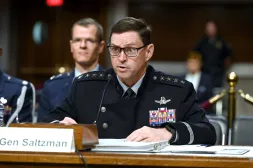Pentagon keen to recruit fresh acquisition workforce talent as it jumpstarts procurement reforms

The Pentagon’s pool of acquisition experts may grow in the months ahead, following major reforms senior officials announced on Friday to drastically revamp the organization’s processes and approach to developing, selling and purchasing products and services.
Many open questions will be puzzled out in the initial implementation phase, according to the Defense Department’s top weapons buyer.
Undersecretary of Defense for Acquisition and Sustainment Michael Duffey shared new details with reporters in an off-camera briefing on Monday regarding next steps, as Pentagon insiders hustle to execute on the new “Acquisition Transformation Strategy” and associated memorandums.
“I’m excited about what [Defense Secretary Pete Hegseth’s] speech will do to attract the interest of high talent — folks who might want to come in and help us do this job. We’re certainly always looking for good people to come in and help. We do have some need for additional personnel, at least in my office, and I suspect across the acquisition workforce,” Duffey told DefenseScoop during a teleconference.
Hegseth spoke for more than an hour in that address on Friday to an audience of select government and industry professionals at the National War College, where he outlined his team’s vision for regulatory and procurement reforms that are intended to reshape and accelerate the military’s adoption of new weapons and technology.
Some of the key shifts include prioritizing commercial solutions and alternative contracting mechanisms; replacing program executive officers (PEOs) with portfolio acquisition executives (PAEs) who will have expanded authority; incentivizing faster deliveries; pivoting the overarching culture to a more urgent wartime footing; and overhauling the nation’s process for Foreign Military Sales (FMS).
“We all know the current acquisition system is too slow, too bureaucratic, and too focused on compliance rather than results. We are facing rapidly evolving threats, and we must be able to adapt, innovate and deliver at the speed of relevance,” Duffey said. “That’s why Secretary Hegseth has directed the redesignation of the Defense Acquisition System to the Warfighting Acquisition System. More than just a name change, it will be a fundamental shift in mindset. We are prioritizing speed, flexibility and performance.”
Notably, the new 46-page strategy directs DOD leaders to generate portfolio “scorecards” that will “capture programmatic performance to deliver capability, scale production, implement commercial solutions, and other key performance metrics.” In turn, the department will use those, which “allow for a ‘by-exception’ approach to oversight,” to assess portfolio and program health.
When asked about what penalties the department may apply to low-scoring performers, Duffey told DefenseScoop that “this is something we’ll work through our implementation.”
“But from my perspective, the performance card is really just an attempt to illuminate what’s working and what’s not. My preference is to focus right now on who’s delivering successfully, and how do we help correct circumstances where it may not be delivering correctly — and that’s probably because we’re in a learning phase here,” he said. “I think that is us figuring out what about the process we’re focused on that is working, and what do we need to improve?”
Duffey also expressed hope that the acquisition workforce initiatives in the strategy will help his team gain “a much better enterprise view and management,” so that they can empower the PAEs to “manage their own workforce effectively and help them grow through the career ladder.”
“But then we also want to take a more robust look at the enterprise acquisition workforce so that we can identify where there might be pockets of need for additional skills or expertise that we can then, from an enterprise view, prioritize for future recruitment,” he noted.
Within 30 days after the directives’ release, Duffey’s team will produce implementation guidance to carry out the strategy.
He said that while considerations are being made around budget line item consolidations across all sorts of program portfolios, it’s a feature that is yet-to-be defined. DOD is working with Congress and the White House Office of Management and Budget to figure it out.
“I know it’s unsatisfying, but all this is to be determined in the implementation [phase]. We’re still working through what the portfolios will be. And I think once we identify what the portfolios will be, then we’ll be thinking through specifically how we assist those portfolios and those portfolio acquisition executives in working through that transition,” Duffey noted.
The department aims to have an open and ongoing discussion with Congress as it moves to implement the strategy, he said, particularly as unanticipated challenges emerge that warrant additional authorities or flexibilities via legislation.
“At this time, we’re not contemplating the cancellation of any programs as a result of this effort,” Duffey told reporters.
In his view, the Ukraine-Russia war is demonstrating how urgency drives performance — and must therefore be injected into DOD’s approaches to acquisition.
“Technology needs to evolve with the rapidly evolving battlefield. We certainly are. It is a priority for us to find ways to better integrate the operators and the acquisition workforce. My hope would be we get to a place where they are working hand-in-hand, especially as we evaluate emerging technology that’s coming out of industry to understand how, number one, warfighters coming out of theater who are most aware of the needs of the joint force can provide direct feedback to industry, and also so that they can be aware of what the art-of-the-possible is from a technology standpoint, which more often than not nowadays, I think, comes from industry as opposed to from the Pentagon,” Duffey said. “And so the more we can close that communication gap, I think the more effectively we’ll be able to iterate on the most effective technology and deliver it to the warfighter.”






